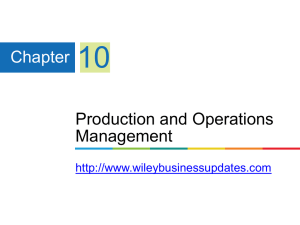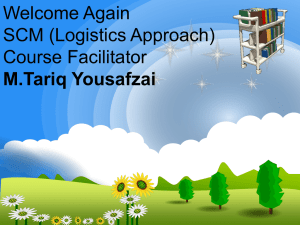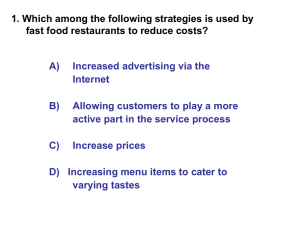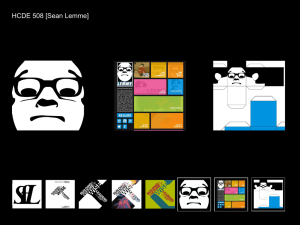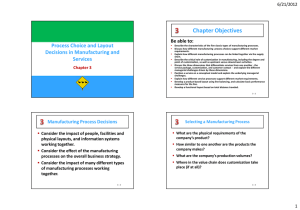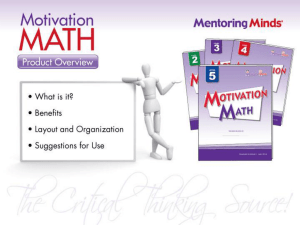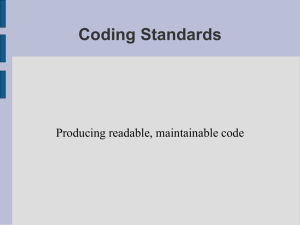Operations
advertisement
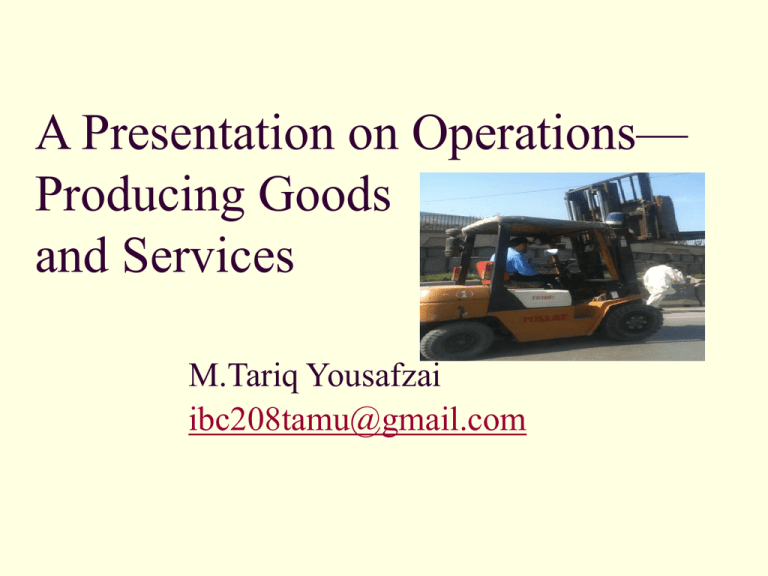
A Presentation on Operations— Producing Goods and Services M.Tariq Yousafzai ibc208tamu@gmail.com Learning Objectives Discuss the strategic value adding roles operations play in the supply chain Appreciate the tradeoffs and challenges involved in production operations Understand the primary production strategies Discuss the primary assembly processes and production methods for goods creation Describe various production process layouts 2 Introduction Operations focus on the “make/build” portion of supply chain. They focus on production of goods and services needed to fulfill customer requirements. Involves the transformation of inputs into outputs that customers demands For example Dell Hospital? 3 Introduction In the execution of these processes, production facilities must interact with supply chain functions that have been discussed Both manufacturers and service providers need ready access to inventories of key inputs from their suppliers. 4 The Role of Production Operations in SCM Many supply chain and logistics activities focus on operations— Procurement operations that provide access to materials; Transportation operations that supports the floe of goods; Distribution operations that streamline order fulfillment and so on 5 The Role of Production Operations in SCM continued… It takes a great deal of effort and coordination to run an effective production operation that is supported by and also supports supply chain Consider the success of Apple iPhone. A great Product design, procurement-assemblysynchronization, and savvy marketing all contributed to the success of commercial juggernaut 6 Production Process Functionality 7 The Production Process funtionality No two processes are organized exactly alike or perform to the same level For example Burger King, McDonalds, and Subway each make sandwiches but have slightly different product strategies that derive their process design and assembly methods Subway and Burger King (to a lesser extent) offer assemble-to-order products McDonald produces products in anticipation of demand using standardized product components. 8 Production Tradeoffs One of the most important issues for supply chain professional to understand is the tradeoffs involved within production operations and between production operations, other supply chain functions, and corporate strategy. All decisions are interrelated and can impact costs, productivity, and quality in other areas. 9 Common tradeoffs 1. Volume-variety tradeoff is a primary issue in production. In situations where production processes have high fixed costs and equipment like chemical production and paper manufacturing, it makes sense to use Volume In contrast, processes that can produce a range of products are said to have economies of scope. 10 (2) Responsiveness and efficiency Related to production facility decisions Centralized production facilities provide operating cost and inventory efficiencies While regional production facilities allow companies to be closer to customers and more responsive Product focused facility and process focused facilities 11 Total Costs of Manufacturing 12 Production tradeoffs continued… Make Versus Buy decision Whether to conduct your own production operations or to outsource production to external suppliers. Internal production processes are more visible and easier to control from quality viewpoint Outsourced production may lead to lower product costs and allow the company to focus its resources on other, more strategic needs. 13 Production Challenges For example US automobile Industry GM and For Needs to compete with Toyota lean production capabilities, Honda product quality,, and be responsive to low cost producers like Hyundai and Kia. Henry Ford mass customization is out of order What he said 14 Production Strategies 15 Lean manufacturing wastes 16 Adaptive manufacturing The goal of this strategy is to provide companies with the ability to replace planning and replanning with execution based on realtime demand. In simple words technologies in this process can enable companies to sense and respond to exceptions that impact manufacturing Limited adoption of this technology 17 18 Assembly Processes Products can be built either according to plan or demand MTS ATO BTO ETO Each assembly process is appropriate for a given situation 19 Make-to-stock (MTS) Traditional Production method where ent-item products are usually finished before receipt of a customer order Customer orders filled from finished goods inventories. Makes it cost effective and shortens lead time Accurate forecasting and inventory control are critical issues in MTS, and warehousing of end products is the norm 20 ATO Assemble-to-order Commences after receipt of order from customer The finished product is generally a combination of standard components and options or accessories specified by the customer In configure-to-order production processes, the manufacturer or customer selects a base product and configures all the variable parameters associated with that product. This is also known as mass customization process 21 BTO (Build/Make-To-Order) Delays assembly until a confirmed order is received (postponement). The end item is generally a combination of standard and custom-designed components that meet the unique needs of a customer It differs from ATO in the higher level of customization and lower volume level of production. 22 ETO Engineer-to-Order Focuses on the creation of highly tailored products for customers whose specifications require unique engineering design or significant customization No two products are identical Each order requires detailed cost estimates and tailored pricing Long lead times Raw materials may be stocked but are not assembled into the finished good until a customer order is received and the product is designed 23 Delayed Differentiation Delayed differentiation is one hybrid strategy in which a common product platform is built to stock. It is later differentiated by assigning to it certain customer-specific features, only after demand is realized. Hence manufacturing occurs in two stages (a) An MTS stage where one or more undifferentiated platforms are produced and stocked (b) An ATO stage where product differentiation takes place in response to specific customer orders 24 Production Process Layout One of the key drivers of how production activities will be carried out is facility layout. It involves the arrangement of machines, storage areas, and other resources within the four walls of a manufacturing or an assembly facility The layout is influenced by the production strategy and assembly process employed by organization 25 Facility Layout Matrix 26 A project layout Is a fixed location layout where the product remains in place for the duration of production Materials and labor are moved to production For example Home building Road construction Tunnels etc 27 A workcenter A process focused layout that groups together similar equipment and or functions The materials move from department to department for completion of similar activities and tasks 28 Manufacturing cell Process focused layout that dedicates production areas to narrow range of products that are similar in processing requirements Four activities involved in its set up (1) Identifying families of parts with similar flow paths (2) Grouping machines to cells based on part families (3) Arranging cells so material movement is minimized and (4) locating large shared machines at the point of use 29 Assembly Line Product focused layout in which machines and workers are arranged according to the progressive sequence of operations need to make a product. Often used for mass production of goods, the assembly steps are completed at workstations that are typically linked to materials handling equipment. 30 Continuous Process facilities Similar to assembly lines, with a product flowing through a predetermined sequence of stops. The main difference is the continuous, rather than discrete nature of flow. Widely used for high volume products such as gasoline, paper towels, and soft drink concentrates These highly automated, capital intensive facilities need to run almost nonstop to gain maximum efficiency 31



